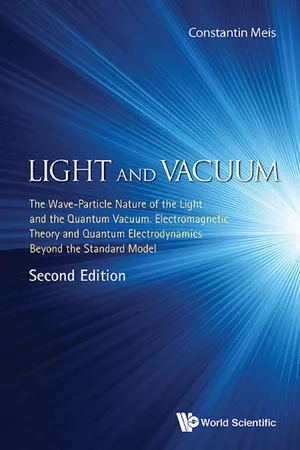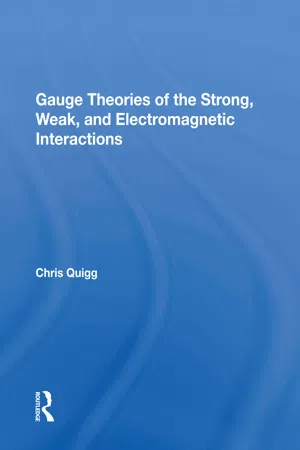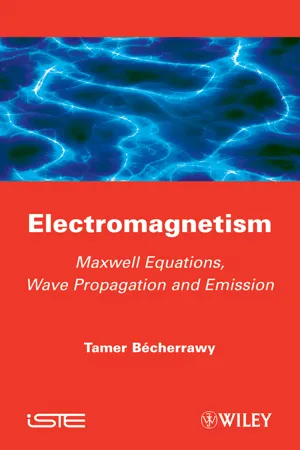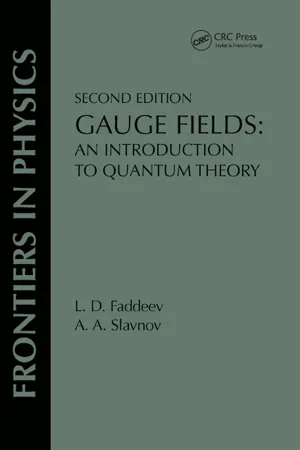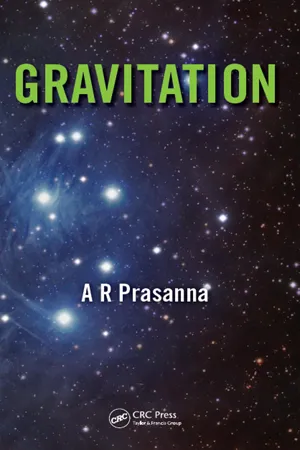Physics
Coulomb Gauge
The Coulomb gauge is a choice of gauge in which the scalar potential of a vector field is set to zero. This simplifies the equations of motion for the field and makes it easier to solve problems involving the field. The Coulomb gauge is commonly used in electromagnetism and quantum field theory.
Written by Perlego with AI-assistance
Related key terms
Related key terms
1 of 4
Related key terms
1 of 3
6 Key excerpts on "Coulomb Gauge"
- Kam Tim Chau(Author)
- 2019(Publication Date)
- CRC Press(Publisher)
This remains a hypothesis that a natural phenomenon must obey law with mathematical beauty (in this case, duality or symmetry in the mathematical structure for B and E). 10.15 Mathematical Theory For Coulomb Gauge We now look at the Coulomb Gauge more closely in this section. Physically, it is also known as the radiation gauge or transverse gauge. 10.15.1 Scalar and Vector Potentials Recalling from our earlier discussion, we have the following condition for Coulomb Gauge: (10.299) ∇ · 2 A = 0 The differential equations for Maxwell’s potentials become (see (10.106) and (10.107)) (10.300) ∇ 2 φ = - ρ ε 0 (10.301) ∇ 2 2 A - 1 c 2 ∂ 2 2 A ∂ t 2 = - μ 0 2 J + 1 c 2 ∇ (∂ φ ∂ t) Before our discussion, we first recall the solution for the Poisson equation ((9.207) of. Chau, 2018): (10.302) φ (2 r, t) = 1 4 π ε 0 ∫ V ρ (2 r ′) 2 r - 2 r ′ d V (2 r ′) This formula will be proved in Section 10.15.3 and it would be used in later discussions. 10.15.2 Transverse Waves or Radiation Gauge To solve for (10.301), we first note that the current J can be decomposed into a transverse or solenoidal part and a longitudinal or irrotational part. More specifically, by definition we have (10.303) 2 J = 2 J t + 2 J l where J l is the irrotational part and J t is the solenoidal part. These components satisfy (10.304) ∇ · 2 J t = 0 (10.305) ∇ × 2 J l = 0 In fact, this is a mathematical truth that any vector can always be decomposed into a solenoidal part and an irrotational part (see Section 1.16 of Chau, 2018). These solenoidal and irrotational parts can be expressed in terms of integrals involving J. To see this, let us consider the following property of the Dirac delta function: (10.306) 2 J (2 r, t) = ∫ V 2 J (2 r ′, t) δ (2 r - 2 r ′) d V (2 r ′) Note from Section 8.10 of Chau (2018) that (10.306) is the basic definition of the Dirac delta function. In the present context, it is given in three-dimensional space- eBook - ePub
Light And Vacuum: The Wave-particle Nature Of The Light And The Quantum Vacuum. Electromagnetic Theory And Quantum Electrodynamics Beyond The Standard Model (Second Edition)
The Wave–Particle Nature of the Light and the Quantum Vacuum. Electromagnetic Theory and Quantum Electrodynamics Beyond the Standard Model
- Constantin Meis(Author)
- 2017(Publication Date)
- WSPC(Publisher)
andin which the time delay appearing in the current and charge densities is conditioned by the speed of the electromagnetic waves in vacuum, c.At that level it is very important to note that the dimension analysis of (3.3.10 ) shows that the vector potential is inversely proportional to time, hence proportional to a frequency.Now, let us consider a different Gauge condition which considerably simplifies the equations. In the so called Coulomb Gauge, the supplementary condition is chosen as:From (3.3.5 ) and (3.3.9 ), we get Poisson’s equation relating the scalar potential to the charge density:whose solution is now independent of the time delay characterizing the charge density:Hence in the absence of charges and from (3.3.1 ), we get a quite important relation between the electric field and the vector potential in the Coulomb Gauge.The last relation is principally used in classical and quantum electrodynamics to calculate the electric field starting from the vector potential.3.4Vector Potential and Electromagnetic Field Polarization
Using the above relations, the propagation equation for the vector potential in vacuum writes In the case of a plane monochromatic electromagnetic field the vector potential is real (from mathematical point of view) and it is expressed in the same way as the electric and magnetic fieldswhere θ is a phase parameter.For the Coulomb Gauge condition to be satisfied, the following relation between the wave vector and the amplitude of the vector potential should hold: entailing that the wave vector is perpendicular to the vector potential so that the electromagnetic wave is called transverse.Taking θ = 0 and using the relations (3.3.15 ) and (3.3.2 ), while putting and - Chris Quigg(Author)
- 2021(Publication Date)
- CRC Press(Publisher)
THE IDEA OF GAUGE INVARIANCE DOI: 10.1201/9780429034978-33.1 Historical PreliminariesWe turn now to a discussion of the theory of electrodynamics, which is both the simplest gauge theory and the most familiar. The foundations for our present understanding of the subject were laid down by Maxwell in 1864 in his equations unifying the electric and magnetic interactions. The electromagnetic potential that one is led to introduce in order to generate fields that comply with Maxwell’s equations by construction is not uniquely defined. The resulting freedom to choose many potentials that describe the same electromagnetic fields has come to be called gauge invariance. We shall see that the gauge invariance of electromagnetism can be phrased in terms of a continuous symmetry of the Lagrangian, which leads, through Noether’s theorem, to the conservation of electric charge and to other important consequences. Although it is clearly possible to regard gauge invariance as simply an outcome of Maxwell’s unification, one may wonder whether a greater importance might not attach to the symmetry itself and thus be led to investigate the degree to which Maxwell’s equations might be seen to follow from the symmetry. Indeed, the idea of gauge invariance as a dynamical principle arose from efforts by Hermann Weyl1 to find a geometric basis for both gravitation and electromagnetism. Weyl’s attempts to unify the fundamental interactions of his day through the requirement of invariance under a space–time-dependent change of scale were unsuccessful. His terminology, Eichinvarianz (Eich = gauge or standard of calibration), has nevertheless survived, and his original program is worth recalling.Consider the change in a function f(x) between the point xμ and the point xμ + dxμ- eBook - ePub
Electromagnetism
Maxwell Equations, Wave Propagation and Emission
- Tamer Becherrawy(Author)
- 2013(Publication Date)
- Wiley-ISTE(Publisher)
2 .9.4. Quasi-permanent approximation
In the general case of time-dependent q v and j , the system is said to be in a variable regime . It obeys Maxwell's coupled equations [9.12] to [9.15] . E and B constitute the electromagnetic field . They are related to the potentials υ and A by the relations B = ∇× A and E = −∇υ − ∂t A . The potentials are given by the retarded expressions [9.41] and [9.42] , the evaluation of which is often difficult; hence, it is necessary to use approximation methods.a) If we completely neglect the variation of q v in time and the motion of electric charges (thus j = 0), the system is in the static regime governed by the equations of2 Some authors consider that the potentials are simply a convenient mathematical tool to calculate the fields. Although the potentials are defined up to a gauge transformation, all the physical quantities are invariant in this transformation. It may be shown using Noether's theorem (see section 1.7 ) that this invariance is related to the conservation law of electric charge [9.2] . In 1959, Aharonov and Bohm showed that the vector potential has quantum mechanical observable effects. More recently, the theory of gauge fields allowed the unification of electromagnetic and weak interactions and possibly strong interactions. Thus, it seems to be the most fundamental theory of physics (the so-called theory of everything) .electrostatics and magnetostatics of permanent magnets, which are Maxwell's time-independent equations[9.45]This is obviously a poor approximation with q v , E S , D S , B S and H S time-independent and magnetism completely uncoupled from electrostatics.b) A better approximation (called permanent regime approximation ) consists of keeping the free current density j - eBook - ePub
Gauge Fields
An Introduction To Quantum Theory, Second Edition
- L. D. Faddeev(Author)
- 2018(Publication Date)
- CRC Press(Publisher)
1 Introduction:Fundamentals of Classical Gauge Field Theory1.1 Basic Concepts and NotationThe theory of gauge fields at present represents the widely accepted theoretical basis of elementary particle physics. Indeed, the most elaborate model of field theory, quantum electrodynamics, is a particular case of the gauge theory. Further, models of weak interactions have acquired an elegant and self-consistent formulation in the framework of gauge theories. The phenomenological four-fermion interaction has been replaced by the interaction with an intermediate vector particle, the quantum of the Yang-Mills field. Existing experimental data along with the requirement of gauge invariance led to the prediction of weak neutral currents and of new quantum numbers for hadrons.Phenomenological quark models of strong interactions also have their most natural foundation in the framwork of a gauge theory known as quantum chromodynamics. This theory provides a unique possibility of describing, in the framework of quantum field theory, the phenomenon of asymptotic freedom. This theory also affords hopes of explaining quark confinement, although this question is not quite clear.Finally, the extension of the gauge principle may lead to the gravitational interaction also being placed in the general scheme of Yang-Mills fields.So the possibility arises of explaining, on the basis of one principle, all the hierarchy of interactions existing in nature. The term unified field theory, discredited sometime ago, now acquires a new reality in the framework of gauge field theories. In the formation of this picture a number of scientists took part. Let us mention some of the key dates.In 1953 C. N. Yang and R. L. Mills, for the first time, generalized the principle of gauge invariance of the interaction of electric charges to the case of interacting isospins. In their paper, they introduced a vector field, which later became known as the Yang-Mills field, and within the framework of the classical field theory its dynamics was developed. - eBook - ePub
- A R Prasanna(Author)
- 2016(Publication Date)
- CRC Press(Publisher)
Chapter 9 Gravity as a Gauge Theory 9.1 IntroductionDevelopments in physics in the twentieth century were heavily based on the principle of symmetry and the associated group structure. Newtonian physics, which was the basis of the classical physics, is governed by the Galilean invariance of its associated laws. Maxwell’s electromagnetism, which did not respect Galilean invariance, had to wait for special relativity to amalgamate with laws of motion, to form electrodynamics, which, in fact, was the first unification of two forces. However, the Lorentz invariance, which has been the cornerstone of post–relativity physics, both for macro and micro–physics along with quantum principles is considered as a very basic requirement for laws of physics. However, with the advent of general relativity and covariance of physical laws the paths of micro and macro physics separated, with gravitation ruling the roost in macro world explaining the cosmic structure of the universe.On the other side, quantum physics dominated the attention of the physicists, who built a beautiful edifice of the elementary particle world explaining almost all experimental results of the twentieth century. Here, along with Lorentz invariance, another invariance was assumed which is the gauge invariance. Though the gauge invariance has played a very prominent role in constructing theories for the microworld, arguments have been sounded, doubting, whether it is a symmetry as expressed by other mathematical structures. Apart from the basic entities like momentum, energy, and angular momentum, which are all associated with the inertial properties of matter, the other physically well understood property associated with the electromagnetism, another fundamental force, is the electric charge, that was known experimentally to be a conserved quantity since the late eighteenth century. Is there a symmetry associated with this? Remarkably coincident events seem to be the discovery of Noethers theorem in 1918, and Hermmann Weyls attempts to unify gravity and electromagnetism, and the consequent discovery of the gauge symmetry, which implies the conservation of electric charge. Interesting and absorbing discussion of these developments have been narrated in the articles by Jackson and Okun [23] , Afriat [7] , and Brading [8] , which give useful perspectives of the historical developments in the discovery of gauge invariance. As has been discussed already in section 3.4 , Maxwell‘s laws of electromagnetism which are Lorentz invariant, can be expressed in terms of a four–vector potential, Ai , representing the three– vector potential,A →and φ, the scalar potential. These two generate the magnetic field,H =, and the electric field,∇ →×A →E = −Gauge invariance demands that one can change the potential, by adding the space–time derivative of any arbitrary function f (xi ) without changing these fields, as given by1 c− ∇ ϕ∂A →∂ t. It is very simple to see that the forms of=A ′iA i+∂ f∂x iE →andH →will not change as the extra term inH →is a Curl of a gradient which is zero, and inE →, the extra term cancels, between the two expressions after taking into consideration the Lorentz signature of the four–metric ηij . In section 3.4.1
Index pages curate the most relevant extracts from our library of academic textbooks. They’ve been created using an in-house natural language model (NLM), each adding context and meaning to key research topics.
Explore more topic indexes
Explore more topic indexes
1 of 6
Explore more topic indexes
1 of 4

